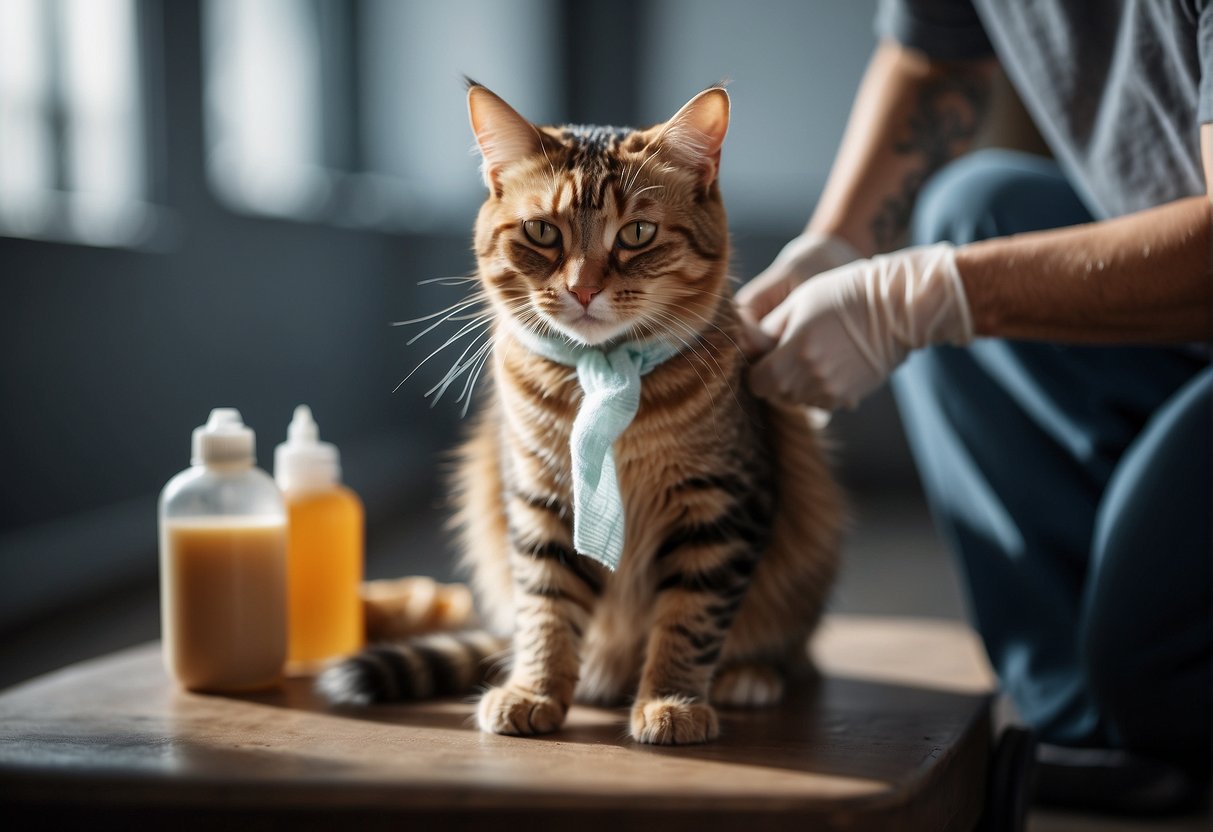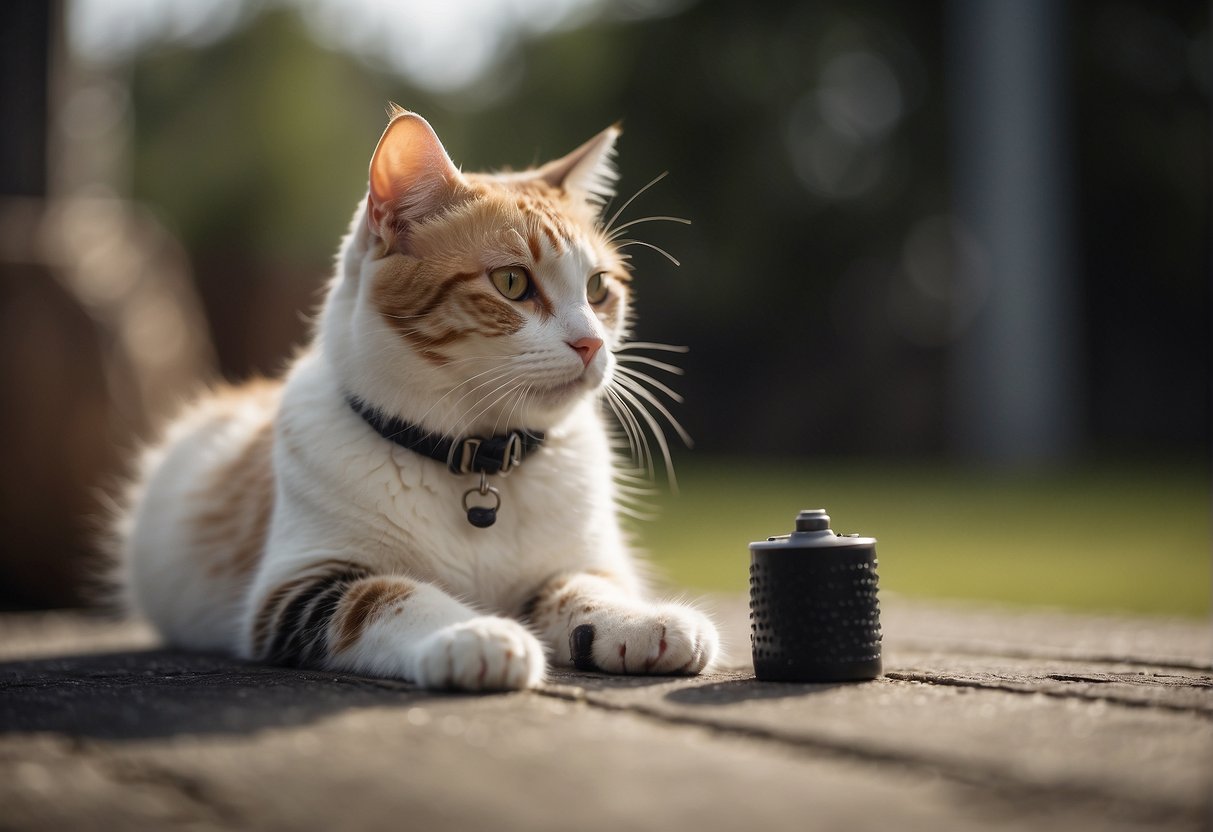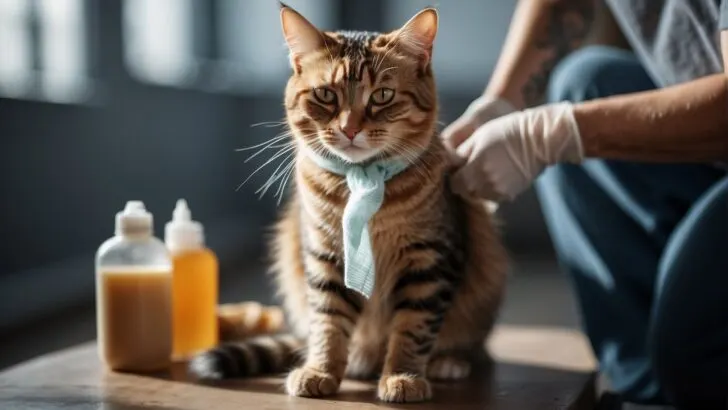Cleaning a cat wound properly is essential for preventing infection and promoting healing. As a seasoned cat owner, I can vouch for the importance of having a well-stocked first aid kit—it’s been a lifesaver in handling minor injuries right at home.
Saline solution, for instance, is a must-have; it’s gentle on the wound and mirrors the pH of body tissues, which helps to minimize additional tissue damage during cleansing.

When tending to wound care, the gentle approach is key. You’ll want to use a syringe or a soft cloth to administer the saline or a mild, pet-safe disinfectant. It’s similar to how you would treat a scrape on your own skin but with extra gentleness to account for your cat’s fur and possible anxiety.
Remember, any signs of heavy bleeding, deep wounds, or infection are cues to seek veterinary attention promptly. For wounds that are superficial, keep an eye on the healing process—it should progress daily, with complete healing typically observed within a week for minor abrasions.
Assessing the Injury

Before diving into the cleaning process, it’s crucial to accurately assess your cat’s injury. This will help you determine the right approach to take and whether professional veterinary care is needed.
Identify the Type of Wound
Cuts: These are typically caused by sharp objects and will appear as clean incisions.
- Abrasions: Superficial wounds such as scrapes, often from rough surfaces.
- Puncture Wounds: Small entry points that can hide deeper damage, commonly from bites or stepping on something sharp.
- Bite Wounds: These may seem small but are prone to infection due to bacteria from the attacker’s mouth.
- Skin Wounds: General term for any damage to the skin, which may or may not breach into deeper tissues.
For each type, carefully examine the wound’s size and depth. If it’s a small, shallow cut or abrasion and the bleeding has stopped, you might be able to manage it at home. Deep puncture wounds and bite wounds often require a vet’s attention, as these can harbor infections and are less visible to the naked eye.
Check for Signs of Infection
Keep an eye out for:
- Redness and Swelling: Some swelling is natural, but excessive redness or swelling can indicate an infection.
- Heat: An infected wound may feel warmer than the surrounding skin.
- Pus or Discharge: Clear fluid is normal, but yellow, green, or odorous discharge is a red flag.
- Behavioral Changes: If your cat is more lethargic or irritable, it may be responding to the pain or discomfort from an infected wound.
Initial Cleaning and Care
When your cat gets a wound, quick and proper initial cleaning and care are critical to prevent infection and ensure optimal healing.
Stopping the Bleeding
First, if the wound is actively bleeding, apply pressure with a sterile gauze pad or a clean cloth. Hold it firmly against the wound for at least 10-15 minutes without peeking; consistent pressure is key for clotting. If bleeding is severe or fails to stop, seek immediate veterinary attention.
Cleaning the Wound
Once bleeding is under control, gently clean the area. Saline solution is your best bet—it’s gentle and effective. You can use a sterile syringe to flush out any debris.
Avoid using hydrogen peroxide or alcohol as these can damage the tissue and delay healing. If you don’t have saline, you can make your own by dissolving one teaspoon of salt in two cups of warm water.
How to make a saline solution:
- Boil 2 cups of water to ensure it’s sterilized.
- Dissolve 1 teaspoon of salt into the boiled water.
- Let it cool before use.
After flushing, softly pat the area dry with another clean gauze or cloth.
Applying Antibiotics and Bandaging
Applying a thin layer of a vet-approved antibiotic ointment can prevent infection and keep the wound moist for healing. Avoid using ointments formulated for humans unless specified by your vet.
If the wound is somewhere your cat can reach, consider a bandage or protective garment to prevent licking, which can introduce bacteria. When bandaging, ensure it’s snug but not too tight, allowing for proper circulation.
Monitoring and Managing the Healing Process
After you’ve cleaned and treated your cat’s wound, the healing process begins. This critical period requires monitoring for signs of proper healing or complications.
Regular bandage changes, vigilance for infection signs, and timely veterinary follow-ups are key practices to ensure your cat’s wound heals successfully.
Change Bandages Regularly
Frequency: Replace your cat’s bandages regularly, typically every 24 hours or as advised by your vet. This prevents moisture and bacteria build-up, which can impede healing.
- Clean Hands: Always have clean hands before touching the wound or bandages to minimize infection risk.
- Materials Needed: Keep sterile gauze and vet-approved wrap on hand.
Watch for Complications
Stay alert for any unusual signs during the healing process, as they might indicate a problem:
- Swelling: Some swelling is normal, but excessive swelling might signal an infection.
- Redness and Heat: A healing wound will be slightly red, yet persistent redness and warmth can point to underlying issues.
- Pus or Odor: These are classic signs of infection. If you notice any, contact your vet.
- Behavior Change: If your cat is unusually lethargic or aggressive, it may be experiencing discomfort from the wound.
Veterinary Follow-Up
- Sutures/Stitches: If your cat received stitches, schedule a follow-up to ensure they’re removed at the correct time and the wound is healing properly.
- Medication: Administer any prescribed antibiotics or pain medication exactly as directed to prevent infection and control pain.
- Progress Check: Regular veterinary check-ups will assess the healing process and adjust treatments if necessary.
Preventing Future Injuries
When your feline friend spends time outside, it’s important to safeguard them from potential hazards. A catio, an enclosed patio designed for cats, can offer a safe outdoor environment that reduces the risk of injury while allowing your cat to enjoy the fresh air.
You can either purchase a pre-made catio or build one to suit your space.
If your cat roams freely outdoors, regularly check your yard for objects that could cause harm, such as sharp tools or toxic plants. For those adventurous outdoor cats, consider a routine to inspect them for cuts or scrapes upon their return.
Maintaining a first aid kit tailored for your cat can be invaluable in preventing infections. Stock it with essentials like saline solution, antiseptic wipes, and bandages specifically designed for pets. Knowing how to properly clean a wound is crucial; cleaning a minor injury promptly can prevent it from becoming infected.
In addition to physical measures, you can:
- Ensure vaccinations and parasite prevention are up to date to bolster their defenses against diseases that could complicate a wound.
- Keep your cat’s nails trimmed to reduce the chances of them inflicting a wound on themselves or others during play or a scuffle.
- Feed your cat a well-balanced diet to promote good health and a strong immune system, which is a natural defense against infection.

My name is James, and welcome to FAQCats!
Along with our team of cat owners, expert pet enthusiasts, and pet professionals, we aim to write engaging helpful, engaging content about cats. At FAQCats we strive to provide content that’s accurate and fun to read. Our team writes about everything related to cats; even the most complex of topics. Through extensive research and caring for our own fur-pals, we’re able to provide something cat owners worldwide will love. Have a look around, and leave us feedback anytime!

